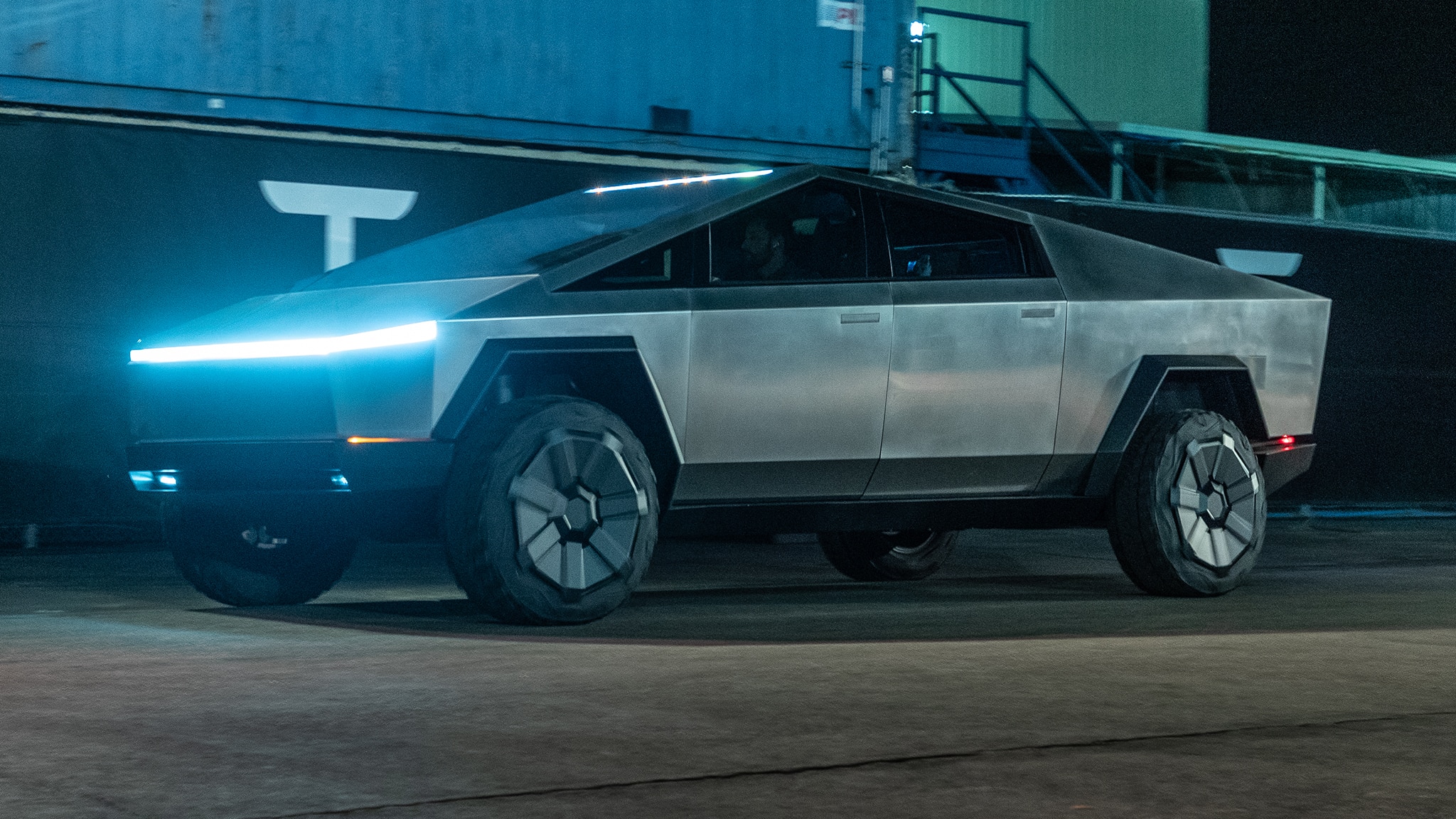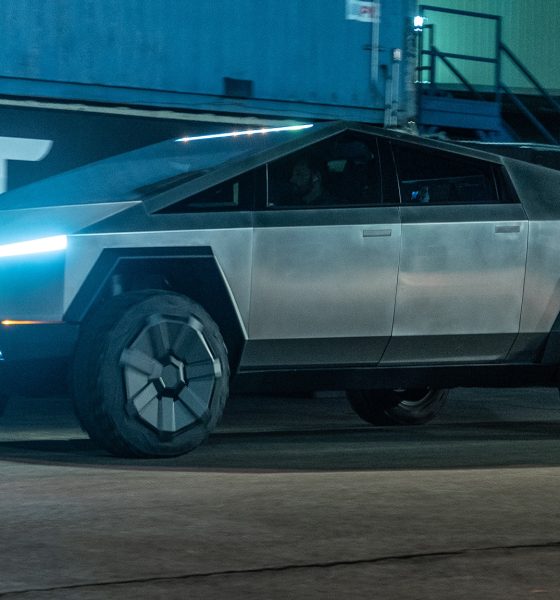

News
Tesla Cybertruck comes in dead last against GM, Ford and Rivian in consumer survey
A recent consumer survey comparing the Tesla Cybertruck to the Ford F-150 Electric, the Rivian R1T, and GM’s unreleased, unannounced electric pickup truck has rendered rather interesting results. Based on the results of the study, which was conducted by Autolist.com, it appears that consumers prefer EV trucks over incumbents like GM and Ford. Consumers specifically mentioned their preference for Rivian and Tesla vehicles. The Cybertruck, with its radical styling, ended up ranking dead last in the survey’s overall rankings.
Among the respondents of Autolist.com’s survey, 50% have never owned a pickup before, while 49% have owned or currently own a truck. One percent of the study’s respondents stated that they were “unsure.” Around ~1,100 respondents were selected for the study between late November and early December, with each one being asked which all-electric pickup they prefer and why.
Interestingly, GM’s unannounced, unconfirmed all-electric pickup was the respondents’ top choice, with the still-unknown vehicle grabbing 29% of the vote. The Ford F-150 Electric came in second with 27% of the vote, while the Rivian R1T came in at a respectable third place with 24%. At the bottom was the Tesla Cybertruck, which was deemed as the top EV pickup choice by 20% of respondents.

While the overall results of the consumer survey seem unfavorable to the Tesla Cybertruck, a look at the study’s detailed results shows something very notable about the upcoming vehicle. Respondents in the survey were asked to pick three reasons why they selected a particular all-electric truck. The reasons selected for the Cybertruck by the respondents were notably different compared to the other vehicles in the survey.
For GM’s unannounced electric pickup, 62% of respondents listed their trust in the GM brand as their reason behind their preference, while 41% listed the expected reliability of the upcoming vehicle. The expected performance of the truck was listed by 37% of respondents as a priority as well. These results mirror that of the Ford F-150 Electric, with respondents’ trust in the Ford brand receiving 54% of the votes, expected reliability getting 52%, and expected performance getting 38%.
These results are very different compared to those gathered for the Rivian R1T and Tesla Cybertruck. For the R1T, it appears that its exterior styling is its biggest draw, as shown by 75% of respondents listing its look as a reason why they would choose the vehicle. Expected vehicle size and performance both were listed by 35% of respondents, and expected practicality and features received 30% of the vote.

In this sense, the Cybertruck’s results are a league of their own, with respondents seemingly prioritizing the vehicle’s entire ecosystem and Tesla’s classic performance. Fifty percent of respondents listed the Cybertruck’s expected performance as a reason they would choose the vehicle, while expected efficiency and Autopilot received a nod from 44% of respondents. Tesla’s Supercharger Network was also listed by 29% of respondents. This, if any, shows that those who prefer the Cybertruck are already familiar with EV ownership, as evidenced by their mention of charging infrastructure and advanced driver-assist systems as key priorities.
In a way, these results show that buyers who are considering the Tesla Cybertruck have preferences that do not necessarily mirror that of usual pickup customers. A part of this discrepancy may be due to a notable difference among respondents who have owned a truck and those that have never owned a pickup before. Respondents who have owned pickups before seemed the most averse to the Cybertruck, with 35% choosing GM’s electric truck as their top choice, 28% choosing the F-150 Electric, 23% opting for the Rivian R1T, and only 14% selecting the Cybertruck. Among respondents who were non-truck owners, the results were flipped, with the Cybertruck being most popular with 25.8% of respondents’ vote, the Rivian R1T getting 24.8%, and the two EV trucks from Ford and GM receiving 24.7% each.
Chase Disher, an analyst at Autolist.com, explained that the results of its survey are actually favorable for all the electric pickups and their respective makers. It shows that the veteran automakers can find a loyal customer base for their all-electric trucks, and it also reveals that an entirely new pickup market could be opened, pushed by vehicles like the Cybertruck. “Frankly, these results are good for all four brands. It shows that Ford and GM can leverage their considerable — and existing — truck followings to boost interest in their EV models. Meanwhile, it shows that Tesla and Rivian could be poised to grab a meaningful share of a crucial new growth segment,” he said.
The full results of Autolist.com’s study could be accessed here.

News
Tesla FSD v14.2.2 is getting rave reviews from drivers
So far, early testers have reported buttery-smooth drives with confident performance, even at night or on twisty roads.

Tesla Full Self-Driving (Supervised) v14.2.2 is receiving positive reviews from owners, with several drivers praising the build’s lack of hesitation during lane changes and its smoother decision-making, among others.
The update, which started rolling out on Monday, also adds features like dynamic arrival pin adjustment. So far, early testers have reported buttery-smooth drives with confident performance, even at night or on twisty roads.
Owners highlight major improvements
Longtime Tesla owner and FSD user @BLKMDL3 shared a detailed 10-hour impression of FSD v14.2.2, noting that the system exhibited “zero lane change hesitation” and “extremely refined” lane choices. He praised Mad Max mode’s performance, stellar parking in locations including ticket dispensers, and impressive canyon runs even in dark conditions.
Fellow FSD user Dan Burkland reported an hour of FSD v14.2.2’s nighttime driving with “zero hesitations” and “buttery smooth” confidence reminiscent of Robotaxi rides in areas such as Austin, Texas. Veteran FSD user Whole Mars Catalog also demonstrated voice navigation via Grok, while Tesla owner Devin Olsen completed a nearly two-hour drive with FSD v14.2.2 in heavy traffic and rain with strong performance.
Closer to unsupervised
FSD has been receiving rave reviews, even from Tesla’s competitors. Xpeng CEO He Xiaopeng, for one, offered fresh praise for FSD v14.2 after visiting Silicon Valley. Following extended test drives of Tesla vehicles running the latest FSD software, He stated that the system has made major strides, reinforcing his view that Tesla’s approach to autonomy is indeed the proper path towards autonomy.
According to He, Tesla’s FSD has evolved from a smooth Level 2 advanced driver assistance system into what he described as a “near-Level 4” experience in terms of capabilities. While acknowledging that areas of improvement are still present, the Xpeng CEO stated that FSD’s current iteration significantly surpasses last year’s capabilities. He also reiterated his belief that Tesla’s strategy of using the same autonomous software and hardware architecture across private vehicles and robotaxis is the right long-term approach, as it would allow users to bypass intermediate autonomy stages and move closer to Level 4 functionality.
News
Elon Musk’s Grok AI to be used in U.S. War Department’s bespoke AI platform
The partnership aims to provide advanced capabilities to 3 million military and civilian personnel.

The U.S. Department of War announced Monday an agreement with Elon Musk’s xAI to embed the company’s frontier artificial intelligence systems, powered by the Grok family of models, into the department’s bespoke AI platform GenAI.mil.
The partnership aims to provide advanced capabilities to 3 million military and civilian personnel, with initial deployment targeted for early 2026 at Impact Level 5 (IL5) for secure handling of Controlled Unclassified Information.
xAI Integration
As noted by the War Department’s press release, GenAI.mil, its bespoke AI platform, will gain xAI for the Government’s suite of tools, which enable real-time global insights from the X platform for “decisive information advantage.” The rollout builds on xAI’s July launch of products for U.S. government customers, including federal, state, local, and national security use cases.
“Targeted for initial deployment in early 2026, this integration will allow all military and civilian personnel to use xAI’s capabilities at Impact Level 5 (IL5), enabling the secure handling of Controlled Unclassified Information (CUI) in daily workflows. Users will also gain access to real‑time global insights from the X platform, providing War Department personnel with a decisive information advantage,” the Department of War wrote in a press release.
Strategic advantages
The deal marks another step in the Department of War’s efforts to use cutting-edge AI in its operations. xAI, for its part, highlighted that its tools can support administrative tasks at the federal, state and local levels, as well as “critical mission use cases” at the front line of military operations.
“The War Department will continue scaling an AI ecosystem built for speed, security, and decision superiority. Newly IL5-certified capabilities will empower every aspect of the Department’s workforce, turning AI into a daily operational asset. This announcement marks another milestone in America’s AI revolution, and the War Department is driving that momentum forward,” the War Department noted.
News
Tesla FSD (Supervised) v14.2.2 starts rolling out
The update focuses on smoother real-world performance, better obstacle awareness, and precise end-of-trip routing, among other improvements.

Tesla has started rolling out Full Self-Driving (Supervised) v14.2.2, bringing further refinements to its most advanced driver-assist system. The new FSD update focuses on smoother real-world performance, better obstacle awareness, and precise end-of-trip routing, among other improvements.
Key FSD v14.2.2 improvements
As noted by Not a Tesla App, FSD v14.2.2 upgrades the vision encoder neural network with higher resolution features, enhancing detection of emergency vehicles, road obstacles, and human gestures. New Arrival Options let users select preferred drop-off styles, such as Parking Lot, Street, Driveway, Parking Garage, or Curbside, with the navigation pin automatically adjusting to the user’s ideal spot for precision.
Other additions include pulling over for emergency vehicles, real-time vision-based detours for blocked roads, improved gate and debris handling, and extreme Speed Profiles for customized driving styles. Reliability gains cover fault recovery, residue alerts on the windshield, and automatic narrow-field camera washing for new 2026 Model Y units.
FSD v14.2.2 also boosts unprotected turns, lane changes, cut-ins, and school bus scenarios, among other things. Tesla also noted that users’ FSD statistics will be saved under Controls > Autopilot, which should help drivers easily view how much they are using FSD in their daily drives.
Key FSD v14.2.2 release notes
Full Self-Driving (Supervised) v14.2.2 includes:
- Upgraded the neural network vision encoder, leveraging higher resolution features to further improve scenarios like handling emergency vehicles, obstacles on the road, and human gestures.
- Added Arrival Options for you to select where FSD should park: in a Parking Lot, on the Street, in a Driveway, in a Parking Garage, or at the Curbside.
- Added handling to pull over or yield for emergency vehicles (e.g. police cars, fire trucks, ambulances).
- Added navigation and routing into the vision-based neural network for real-time handling of blocked roads and detours.
- Added additional Speed Profile to further customize driving style preference.
- Improved handling for static and dynamic gates.
- Improved offsetting for road debris (e.g. tires, tree branches, boxes).
- Improve handling of several scenarios, including unprotected turns, lane changes, vehicle cut-ins, and school buses.
- Improved FSD’s ability to manage system faults and recover smoothly from degraded operation for enhanced reliability.
- Added alerting for residue build-up on interior windshield that may impact front camera visibility. If affected, visit Service for cleaning!
- Added automatic narrow field washing to provide rapid and efficient front camera self-cleaning, and optimize aerodynamics wash at higher vehicle speed.
- Camera visibility can lead to increased attention monitoring sensitivity.
Upcoming Improvements:
- Overall smoothness and sentience.
- Parking spot selection and parking quality.








